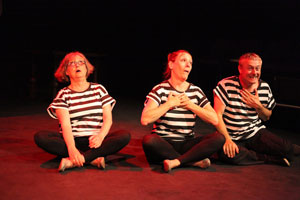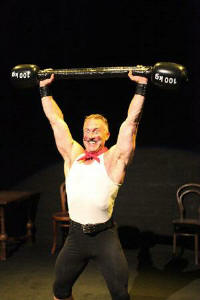Potters Amazing Fleas and Lightning Under The Waves
Crucial Image Theatre Company
|
Director David Hovatter is known for using lots of physical movement, object metamorphosis, few props, strategic lighting tricks and great dialogue in his devised work. And the latest two productions from his theatre company, Crucial Image, in their own ways, showcased a lot of these conventions and his wit – Potters Amazing Fleas more so than Lighting Under the Waves.
David says the origins of Potter’s Amazing Fleas grew from a newspaper article about a couple prosecuted for neglect of an elephant in their circus. Indeed, an elephant features as a bit of a hero in the play; collecting much-needed food, encouraging romance and stopping some bandits.
The music by French composer Pascal Comelade is quite extraordinary and lends itself perfectly to a feeling of whimsical delicate quaintness, combined with striking melodic continuous notes that keep you concentrating in a steady rhythm.
…perfect for the continuous action of the play that tells the story of a circus troupe that performs without reward. They decide to go to America to seek fortune, but travel on the Titanic on its final voyage. We follow a surviving spirited pair of performers, who like each other romantically, and see how they find America once they arrive.
For a simple plot, it’s very clever indeed. All sequences are in mime, except for two words – ‘America’ and ‘Bang!’ These were well thought out and added a grander impact to the character’s joy of moving to America and the Titanic’s crash.
Interspersed with great amounts of audience interaction, the initial opening scenes are the circus character’s live circus show to the stage audience. Each actor – from the Strongman to the High-wire Acrobat – has a generous window to showcase their characters, acrobatics and muscle-tension movement work.
It was clear that the actors enjoyed their roles. There was clear enthusiasm, with defined and aptly predictable characteristics for each. And it worked in the context of early entertainment of circus companies, which were aimed at providing simple and accessible jokes for the whole family.
With the first part of the public show over, the story retires to life off-stage and this is by far the most interesting. Without words, the dynamic between the characters are hinted at subtly and, silently, you begin to understand the life they lead.
One of the funniest scenes was Fleaman’s fleas’ accidental drowning: Jolyon Houghton’s exaggerated mouth to mouth medical efforts was followed by a tragically funny burial. The clown, played by Jessy Moat, did tumbles, running jumps and headstands to make her character’s heavy-hat gag work and it was worth the effort.
A simple blue sheet and wooden ship provided the visuals for the stage by stage voyage of the Titanic. In the middle of the story are sea-sickness and disappearing food gags. And with simple pleasure, you slip into the realm of the play and enjoy the charm of it with childish glee.
The second play, named the ‘Cable’ by cast members, tells the story about the little told story of the laying of the Transatlantic Cable. Labelled as the ‘work-in-progress’, the cast began with no script albeit they had two musical pieces ready for rehearsal. I find out later that the rehearsal had begun with three weeks until the run-time and there was less collaboration, and unfortunately it shows.
The label affords some leniency, though the rushed staging which mainly consisted of actors standing in line formations and randomly reading parts of the script, created no unity or sense of story.
The two characters that had some form were David Hovatter’s take on Isambard Brunel – who functioned as the plot’s protagonist ‘ghost’ – and Robert Baker-Glenn’s David Lewis – who narrated the play, but his shop owner instincts have him selling his wares at every opportunity.
There was the beginning of a much needed thread in the play, in Tom and Mary’s characters, who were lovers across different places, writing to each other by letter. A tragic irony could have been developed in the lengthy wait on news by mail, during the building of the more modern and speedier telegram wires.
The musical pieces, headed by Richard Soulsby and Jasmine Hind’s skilled voices, were the highlight.
In terms of a beginning of a play, it is a promising one. David’s script is informative and lively, based on researching accounts from people who were actually there during this time in telecoms history. There’s admiration for his open invitation for feedback, which is rarely done these days, and unanimous opinion from audience members confirms that the story has potential.
1st – 3rd August, Questors Theatre
Meena Toor @journomeena
August 8th 2013


